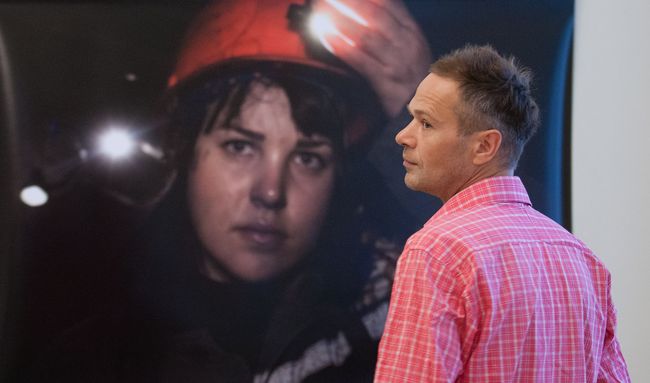Ode to labor
“Victims’ Victories” – a project studying life behind the frontline in Donbas
“Philosopher Walter Benjamin believed that we are doomed to read the history written by the victors. This exhibition raises the question whether we can read a history written by the victims. And whether those people would remain victims, should they co-author our common history. Does this situation have a victor, after all?” muses Yevhenia Bilorusets, artist and author of the exhibit.
The project is based on a cycle of photos and texts by Bilorusets, collected since 2014 in the cities and towns in Ukraine’s east, next to the warfare zone. In particular, in Debaltseve, Lysychansk, Vuhlehirsk, Pryvillia, and Popasna. The co-authors of the exhibit were architect Ivan Melnychuk and curator Tetiana Kochubynska. The project was also made possible thanks to the support from various trade union, volunteer, and human rights initiatives.
“A DOCUMENT OF FRIENDSHIP AND LOVE”
Many photos of Bilorusets feature coal miners. They are filthy, tired, yet unexpectedly handsome and smiling. “Even before the war I felt the urge to study labor via photography,” shares Bilorusets. “I worked on themes related to labor migration in the west of Ukraine, and shot my pictures in local coal mines. I was extremely anxious to go east and study the life of local state-owned enterprises. When the war broke out, I imagined for some reason that life there had stopped. This was the picture created by news from Donbas. I decided to risk it and venture a trip to the east. At least, I would make sure that news is true to life. When I first arrived in the east, I felt the breath of war, but realized almost immediately that all I had known about Donbas in relation to the conflict was a lie. Life goes on in the frontline area, even if it seems strange. All enterprises are working, schools and hospitals function, and so do the coal mines.”
The distorted perception of the events in Donbas was rendered via the structure of the exposition created by Ivan Melnychuk. A large panoramic photo with an industrial landscape, placed on a concave wall, was a real eye-catcher. “I decided to make such a curved surface because Ukrainians see the conflict in Donbas as though in a false mirror,” comments Melnychuk. “The easterners are treated like victims of violence, as if what is going on were their fault. We wanted to dispel such an impression with our exhibit.”

Bilorusets calls this project “a document of friendship and love.” At the same time it is an attempt at tricking the viewer by appealing to the document. “It is as if I showed a document that ruins people’s fantasies. But the exhibit also demonstrates that any reality, presented by someone, is a subjective picture of the world,” explains the artist. Next to the photos are texts, often these are fragments of conversations with their characters. According to Bilorusets, the texts “force” the photographs to say exactly what the author intended to tell. By the way, late this year a book is supposed to appear which will be based on the interviews recorded by the artist during her trips to the east.
“IT IS TOTAL LULL, PEOPLE ARE IN DESPAIR”
One of the heroines of the project, human rights advocate and lawyer Vira Yastrebova, considers a photo portraying her to be the sign of the epoch. The picture was taken in the fall of 2014 at the Pryvilnianska Coal Mine in Lysychansk, some 700 meters under the surface. “Yevhenia suggested accompanying her and talking to the miners to get first-hand impressions of their work. Since I come from Debaltseve, Donetsk oblast, which is a miners’ region, I have always been fascinated by mines, but until then I had never had an opportunity to visit one. Before the war I was a state servant and worked at a law court, so there was no way I could come in contact with coal production,” remembers Yastrebova. “Soon after that descent into the mine I realized that it was impossible to live in Debaltseve: the communications were disrupted, my apartment was destroyed by a projectile. I found a way to get a job transfer, and literally a couple of weeks later I moved to Lysychansk, where I am currently living.” Now Yastrebova works as a legal consultant at a state-owned enterprise and considers herself to be a troublemaker because she helps miners fight for their rights.
Speaking of the rights. The exhibit ends in a sort of epilog: the last of its rooms displays photographs from the archive of the Confederation of Free Trade Unions of Ukraine featuring miners’ protests from 1989 to 2003. “Today the tensions are disastrous. People cannot protest openly because they are intimidated and threatened with reprisals, and the management of enterprises uses all restrictive measures available,” said Yastrebova describing the situation at the Donbas coal mines. “Meanwhile, the workers at the state-owned Lysychanskvuhillia have not seen their wages for five months already, while the company includes enterprises of strategic importance for the city. It is total lull, people are in despair.”
The project “Victim’s Victories” inspired serious and constructive thinking. No wonder that one of its important constituent parts was a discussion program with the participation of researchers from Ukraine, Belarus, and Germany. Shifting the focus onto the people and communities whose sole existence sometimes impeded the spread of armed violence: this is how the authors defined the goal of their exhibit. Generally speaking, victory is quite a relative concept. It seems that for the heroes of this project it would manifest in the possibility to work at their native coal mine, despite all the surrounding chaos, in almost-infernal conditions. Yet with a heavenly smile on their faces.
Newspaper output №:
№49, (2016)Section
Time Out





